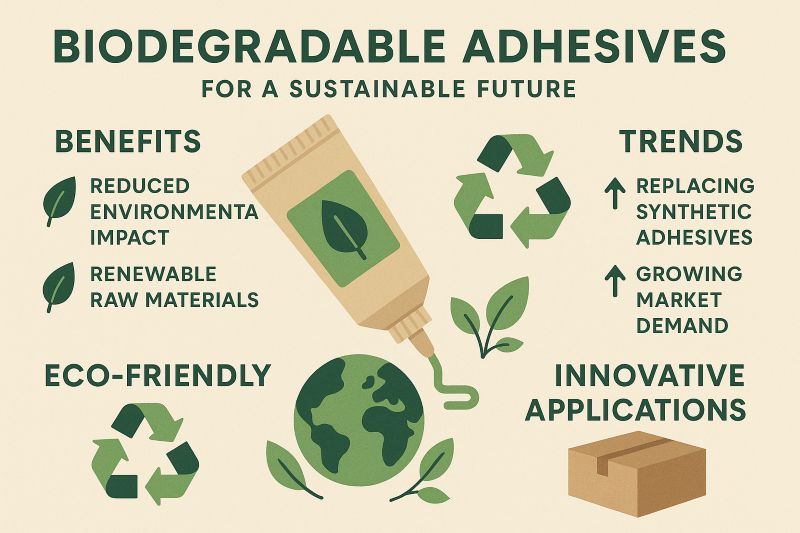
Defining Biodegradable Adhesives
Types of Hot Melt Adhesives
Importance of Biodegradability
Methods of Adhesive Application
Latest Trends in Adhesive Science
Strategies for Eco-Friendly Use
Future of Biodegradable Adhesives
Frequently Asked Questions (FAQ)
Biodegradable adhesives are transforming the industry by offering eco-conscious bonding solutions. These materials are designed to break down naturally, minimizing long-term environmental impact. In the hot melt segment, these adhesives are often composed of renewable ingredients such as plant-based resins and natural waxes. By meeting the dual demand for high-performance bonding and sustainability, they are becoming ideal choices for companies pursuing greener operations.
Hot melt adhesives come in a range of formulations, each serving distinct industrial needs. Traditional types typically rely on synthetic polymers, delivering strong bonds but raising ecological concerns. In contrast, biodegradable variants incorporate natural raw materials and are engineered to decompose over time. These adhesives maintain structural integrity during use but ultimately return to nature, making them highly suitable for environmentally responsible applications.
Biodegradability is becoming a non-negotiable feature in industrial materials. In adhesives, this trait directly supports environmental goals by reducing landfill accumulation and decreasing reliance on fossil-based inputs. The use of biodegradable hot melts allows businesses to meet regulatory compliance, customer expectations, and internal ESG (Environmental, Social, Governance) objectives without compromising bonding strength or efficiency.
Applying biodegradable hot melt adhesives requires techniques that ensure precision and efficiency. Common methods include:
Roll coating for wide-area uniform application
Spray systems for selective bonding and reduced material use
Extrusion equipment for detailed, high-accuracy application
These techniques not only optimize the performance of biodegradable formulations but also reduce waste, aligning application methods with sustainability goals.
Recent innovations in adhesive technology focus on combining functionality with environmental responsibility. Notable trends include:
Increased use of renewable raw materials
Enhanced formulations for temperature resistance and durability
Integration with automated systems for clean and controlled application
These developments indicate a clear move toward adhesives that perform under industrial conditions while also satisfying eco-conscious manufacturing protocols.
Industries aiming to reduce their environmental footprint can take several strategic steps:
Evaluate adhesive ingredients for bio-based content
Match application methods to minimize overuse or spillage
Train operators on efficient usage practices
Choose suppliers that prioritize sustainability across the supply chain
When implemented correctly, these strategies ensure biodegradable adhesives deliver on both performance and ecological responsibility.
Looking ahead, biodegradable adhesives are expected to take on an even more prominent role in the global adhesive market. Ongoing research is driving improvements in raw material sourcing, adhesive longevity, and industrial scalability. As industries shift toward circular economy principles, these adhesives will become critical enablers of sustainable manufacturing systems across sectors such as packaging, electronics, and automotive components.
What are biodegradable adhesives?
They are adhesives made from renewable materials that naturally decompose, helping reduce long-term environmental impact.
How are they different from traditional adhesives?
Traditional adhesives often use synthetic, petroleum-based materials. Biodegradable adhesives use natural ingredients and offer sustainable disposal benefits.
Why is biodegradability important?
It reduces landfill waste, supports sustainability goals, and aligns with regulatory trends toward environmentally friendly manufacturing.
What application methods are used for biodegradable adhesives?
Common methods include roll coating, spraying, and extrusion, each tailored to ensure efficient usage with minimal environmental impact.
What are current trends in adhesive science?
Trends include the use of bio-based components, automated application integration, and increased temperature and durability performance.
How can companies use biodegradable adhesives effectively?
By matching adhesive type to application need, ensuring efficient application, and prioritizing sustainable sourcing in procurement strategies.
What does the future hold for biodegradable adhesives?
They are expected to become standard in many industries as performance improves and regulatory and consumer demand for eco-friendly products grows.
Are there examples of biodegradable hot melt adhesives?
Yes. While many commercial names exist, the focus is on formulations using plant-derived resins, biodegradable waxes, and other renewable ingredients.